Control and coordination is an important topic in Class 10 Science (Biology). It involves the nervous system and endocrine system, which work together to regulate and coordinate various functions in the body. If you're struggling with this topic, these simplified notes can help you understand it better.
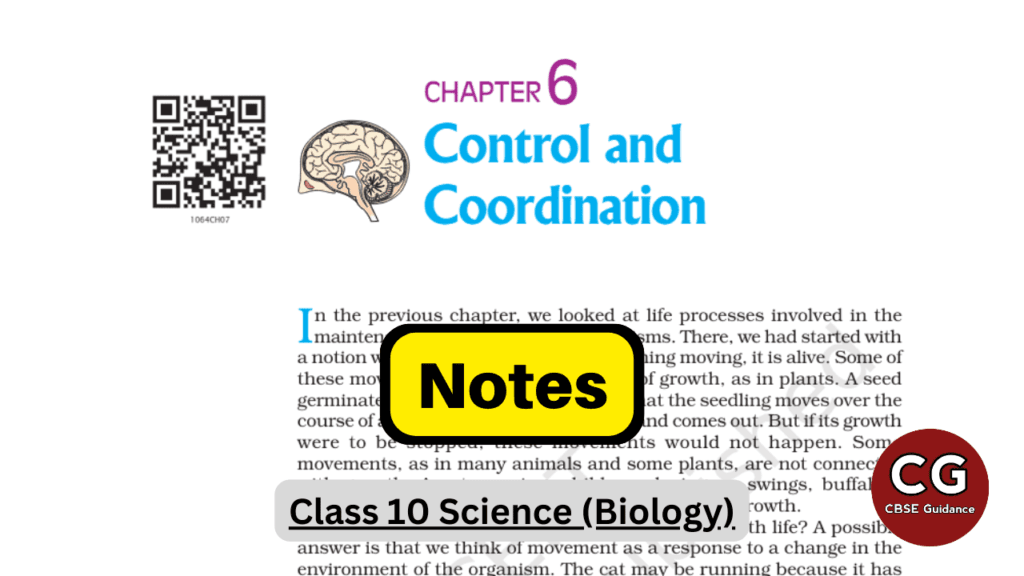
| Subject | Science (Biology) |
| Class | 10 |
| Board | CBSE & State Boards |
| Chapter No. | 6 |
| Chapter Name | Control and Coordination |
| Type | Notes |
| Session | 2024-25 |
Failure is Success in Progress!
- Albert Einstein
Class 10 Science Chapter 6 Control and Coordination Notes
Table of Contents
Introduction
- Life processes (R, E, N, T) are involved in the maintenance functions of living organisms.
- A cat running, children playing on swings, buffaloes chewing cud – these are not movements caused by growth. These movements are a response to a change in the environment of the organism.
- All these movements, in response to the environment, are carefully controlled.
- Living organisms must use systems to provide control and coordination.
- Specialized tissues are used to provide these control and coordination activities.
Animals - Nervous System
In animals, control and coordination are provided by nervous and muscular tissues.
All information from our environment is detected by the specialized tips of some nerve cells.
The receptors are usually located in our sense organs, such as the inner ear, the nose, the tongue, and so on.
| Olfactory receptors (detects smell) | Nose |
| Thermo receptors (temperature receptors) | Skin |
| Gustatoreceptors (detects taste) | Tongue |
| Photoreceptors (detects light) | Eye |
Structure of a Neuron
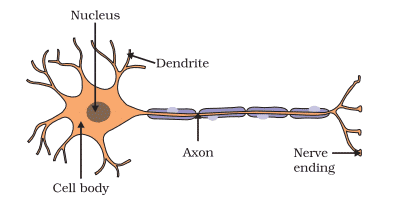
- Information is first received at dendrite.
- It travels through the axon.
- It is released at the nerve ending/axon terminal.
The electrical impulse travels in a neuron from Dendrite → cell body → axon → axonal end.
A gap between a pair of adjacent nerve cell over which nerve impulses passes is called the synapse.
What happens in Reflex Actions?
Reflex actions are those that are performed without thinking about it, or without feeling in control of our reactions.
The path through which signals are transmitted from a receptor to a muscle or a gland is called the reflex arc.
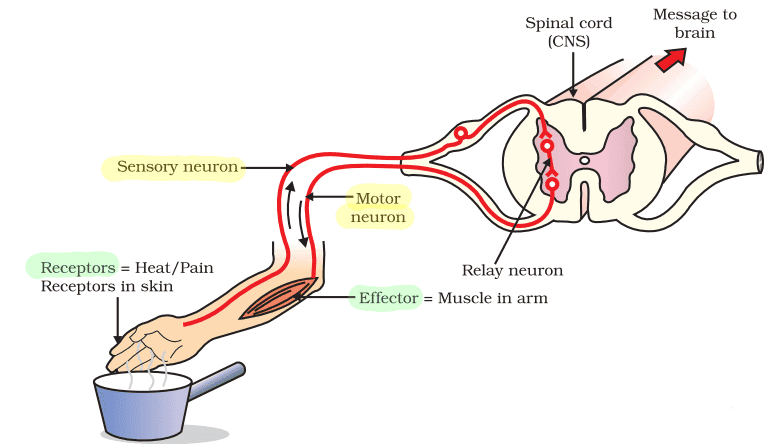
Sense Organ -----(Sensory neuron)→ Spinal Cord (CNS) ----(Motor neuron)→ Effector (Muscle in arm).
Human Brain
The spinal cord is made up of nerves that supply information to think about.
The brain and spinal cord constitute the central nervous system. They receive information from all parts of the body and integrate it.
The communication between the central nervous system and the other parts of the body is facilitated by the peripheral nervous system consisting of cranial nerves arising from the brain and spinal nerves arising from the spinal cord.
The brain has three major parts or regions, namely the fore-brain, mid-brain, and hind-brain.
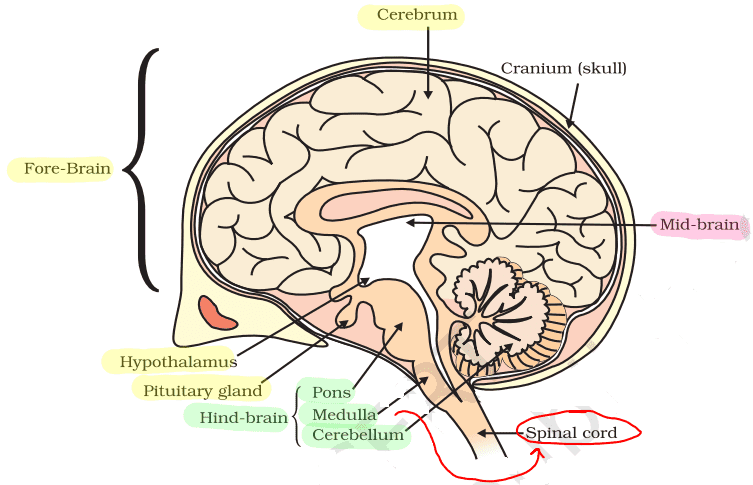
Forebrain
- Cerebrum: The cerebrum is the largest part of the brain and is responsible for higher-order functions such as thinking, planning, learning, memory, emotions, and language.
- Thalamus: The thalamus is a relay station for sensory information from the body to the cerebrum. It also helps to regulate sleep, wakefulness, and emotions.
- Hypothalamus: The hypothalamus is a small but important structure that regulates a variety of body functions, including hunger, thirst, body temperature, and sexual behavior.
Midbrain
- The midbrain is involved in visual and auditory reflexes, in maintaining consciousness, arousal, and attention.
Hindbrain
- Pons: The pons is a structure that connects the midbrain to the medulla. It is involved in motor control, respiration, and sleep.
- Medulla oblongata: The medulla oblongata is the lowest part of the brainstem. It is involved in a variety of vital functions, including breathing, heart rate, blood pressure, and digestion.
- Cerebellum: The cerebellum is a small structure that is located behind the brainstem. It is involved in coordination, maintaining posture and balance of the body, and motor learning.
How are these Tissues protected?
The brain is covered with a cranium and the spinal cord is protected by the vertical column or backbone. These bony covers protect both from external injuries. Both the brain and spinal cord are covered with three membranes called meninges. The space between meninges is filled with a fluid called cerebrospinal fluid which protects them from mechanical shock.
How does the Nervous Tissue cause Action?
When a nerve impulse reaches the muscle, the muscle fibre must move. Muscle cells move by changing their shape so that they shorten.
Muscle cells have special proteins that change both their shape and their arrangement in the cell in response to nervous electrical impulses. When this happens, new arrangements of these proteins give the muscle cells a shorter form.
Coordination in Plants
Plants show two different types of movement –
- one dependent on growth
- the other independent of growth.
1. Immediate Response to Stimulus (Movement independent of growth):
Plants also use electrical-chemical means to convey this information from cell to cell, but unlike in animals, there is no specialized tissue in plants for the conduction of information.
Instead of the specialized proteins found in animal muscle cells, plant cells change shape by changing the amount of water in them, resulting in swelling or shrinking, and therefore in changing shapes.
2. Movement Due to Growth:
Some plants like the pea plant climb up other plants or fences by means of tendrils. These tendrils are sensitive to touch. When they come in contact with any support, the part of the tendril in contact with the object does not grow as rapidly as the part of the tendril away from the object. This causes the tendril to circle around the object and thus cling to it. More commonly, plants respond to stimuli slowly by growing in a particular direction. Because this growth is directional, it appears as if the plant is moving.
The movements which are in a particular direction in relation to the stimulus are called tropic movements. Tropic movements happen as a result of the growth of a plant part in a particular direction. There are four types of tropic movements, viz. Phototropic, Geotropic, Hydrotropic, and Thigmotropic.
- Phototropic movement: The growth in a plant part in response to light is called phototropic movement. Stems usually show positive phototropic movement, while roots usually show negative phototropic movement.
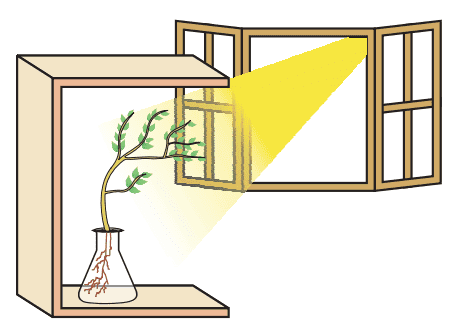
- Geotropic movement: The growth in a plant part in response to gravity is called geotropic movement. Roots usually show positive geotropic movement, i.e., they grow in the direction of gravity. Stems usually show negative geotropic movement.
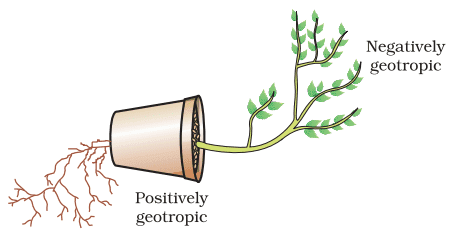
- Hydrotropic movement: When roots grow in the soil, they usually grow toward the nearest source of water. This shows a positive hydrotropic movement.
- Thigmotropic movement: The growth in a plant part in response to touch is called thigmotropic movement. Such movements are seen in the tendrils of climbers. The tendril grows in a way so that it can coil around support. The differential rate of cell division in different parts of the tendril happens due to the action of auxin.
Limitations to the use of electrical impulses:
- Firstly, they will reach only those cells that are connected by nervous tissue, not each and every cell in the animal body.
- Secondly, cells cannot continually create and transmit electrical impulses.
Chemical communication
If, instead of generating an electrical impulse, stimulated cells release a chemical compound, this compound would diffuse all around the original cell.
This will be slower, of course, but it can potentially reach all cells of the body, regardless of nervous
connections and it can be done steadily and persistently.
Different plant hormones help to coordinate growth, development, and responses to the environment. They are synthesized at places away from where they act and simply diffuse to the area of action.
Plant Hormones
- Auxin: When growing plants detect light, a hormone called auxin, synthesized at the shoot tip, helps the cells to grow longer. When light is coming from one side of the plant, auxin diffuses towards the shady side of the shoot. This concentration of auxin stimulates the cells to grow longer on the side of the shoot which is away from light. Thus, the plant appears to bend towards the light.
- Gibberellins: Gibberellins help in the growth of the stem.
- Cytokinins: Cytokinins promote cell division, and it is natural then that they are present in greater concentration in areas of rapid cell division, such as in fruits and seeds.
- Abscisic acid: It inhibits growth. Its effects include wilting of leaves.
Hormones in Animals
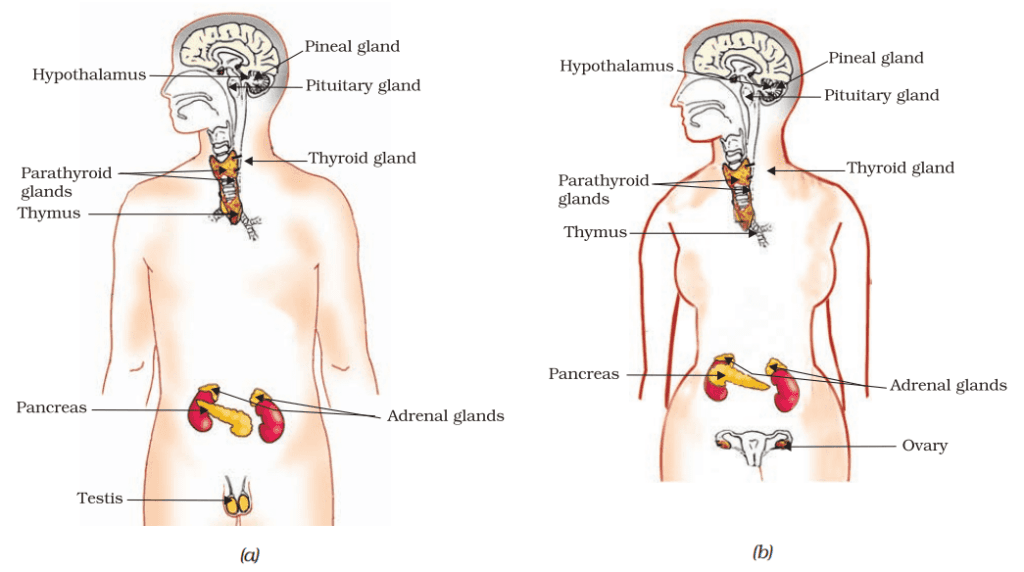
Adrenaline: The emergency hormone in our body is adrenaline. It helps in coping during emergencies as it is secreted directly into the blood and carried to different parts of the body as a result the heart beats faster, resulting in a supply of more oxygen to our muscles. The blood to the digestive system and skin is reduced due to the contraction of muscles around small arteries in these organs. This diverts the blood to our skeletal muscles. The breathing rate also increases because of the contraction of the diaphragm and rib muscles. All these responses together enable the animal body to be ready to deal with the emergency situation.
Thyroxine:
- Iodine is necessary for the thyroid gland to make thyroxin hormone. Thyroxin regulates carbohydrate, protein, and fat metabolism in the body so as to provide the best balance for growth.
- In case iodine is deficient in our diet, there is a possibility that we might suffer from goitre. One of the symptoms of this disease is a swollen neck.
Growth Hormone:
- The growth hormone is one of the hormones secreted by the pituitary. Growth hormone regulates the growth and development of the body.
- If there is a deficiency of this hormone in childhood, it leads to dwarfism.
Testosterone: It is secreted by the testes in males. Its functions include the development of male sex organs, hairs in public parts, cracking of voice, and changes associated with puberty.
Oestrogen: It is secreted by ovaries in females. Its functions include the development of female sex organs, regulates the menstrual cycle, and changes associated with puberty.
Insulin: This is a hormone that is produced by the pancreas and helps in regulating blood sugar levels. If it is not secreted in proper amounts, the sugar level in the blood rises causing many harmful effects (diabetes).
Releasing Hormones: It is released by the hypothalamus. Stimulates pituitary gland to release hormones.
Important Difference Betweens
1. Involuntary Actions Vs Reflex Actions
| Involuntary Actions | Reflex Actions |
| 1. Broader category. | 1. Specific response to stimuli. |
| 2. Do not need any kind of stimuli to work. | 2. Require stimulus for action. |
| 3. Regulated by brain. | 3. Regulated by spinal cord. |
| 4. May be quick or slow. | 4. Always quick. |
| 5. All involuntary actions are not reflex actions. | 5. All reflex actions are involuntary actions. |
| 6. Examples: Heartbeat, breathing, digestion, etc. | 6. Examples: blinking, kneejerk, hand withdrawal, etc. |
2. Nastic Movements vs Tropism
| Nastic Movements | Tropic Movements |
| 1. Growth independent | 1. Growth-dependent responses |
| 2. Happens due to cellular changes (changes in water pressure) | 2. Happens due to plant hormones |
| 3. Fast Response | 3. Slow response |
| 4. Non-directional | 4. Directional |
| 5. Example: Movement of leaves of the sensitive plant (Touch me not). | 5. Example: Movement of shoot towards light. |
3. Movement of leaves in sensitive plant Vs Movement in legs
| Movement in sensitive plant | Movement in legs |
| 1. Response to stimulus (involuntary action) | 1. Voluntary action. |
| 2. No special tissue for information transfer | 2. CNS & PNS for information exchange. |
| 3. Movement due to water loss in leaves. | 3. Special proteins help muscles contract. |
4. Nervous System Vs Hormonal System
| Nervous System | Hormonal System |
| 1. Fast speed | 1. Slow speed |
| 2. Electrical impulses travel through nerve fibre | 2. Chemical messengers (hormones) travel through blood. |
| 3. Short-lived effect | 3. Long-lasting effect |
| 4. Cannot reach all cells in the body. | 4. Can reach all cells in the body. |
Download Class 10 Science Chapter 6 Control and Coordination NCERT Underlined PDF
| Must Read: Control and Coordination Class 10 Important Questions with Answers to get an idea of the different types of questions asked from this chapter. |
| You Might Also Like: CBSE Class 10 Notes CBSE Class 10 Important Questions and Answers |
Hope you liked these notes on Class 10 Science Chapter 6 Control and Coordination. Please share this with your friends and do comment if you have any doubts/suggestions to share.
Hello sir I’m your student I studied my class 10 with your help and got 85%. Thankyou so much for teaching in a very clear and good way 💯❣️. Sir I have request for you as you are currently not uploading 10th videos could you please teach physics or chemistry of class 11 …..I know it is very very difficult for you and challenging too but sir I am having very problem no teacher on YouTube is explaining with ncert book with so much clarity they are just using board and making long videos like 5 hours even in that too they just start from anywhere from the book. Sir i know maybe it’s is very difficult for you but please reply could you do so please answer sir please. And thankyou for everything ❣️💯💯💯💯💯💯💯.
Amazing
Class notes of chapter 11 The human eye not available. Please upload this
I wanted to take a moment to express my heartfelt congratulations to you for the incredible work you’ve done in the field of education. Your dedication, passion, and innovative approach have not only inspired countless students but also set a remarkable standard for others in the profession.
Your contributions are making a lasting impact, and I am truly grateful for the difference you are making in so many lives. Keep up the amazing work!